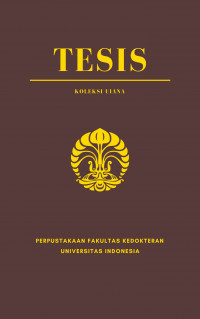Tesis
Left Ventricle End Diastolic Volume Index Sebagai Prediktor Terhadap Kejadian Low Cardiac Output Syndrome Pascaoperasi Penutupan Defek Septum Atrium Sekundum = Measurement of the Left Ventricle End Diastolic Volume Index As Predictor of Low Cardiac Output Syndrome After Closure of Secundum Atrial Septal Defect.
Latar belakang : Defek septum atrium sekundum (DSAS) adalah salah satu penyakit kongenital yang paling sering dijumpai pada pasien anak dan dewasa. Prevalensi DSAS sebanyak 80 kasus menurut database Bedah pediatrik dan kongenital PJNHK. Salah satu morbiditas pascaoperasi penutupan DSAS yaitu LCOS. LCOS akibat dari volume overload dari atrium-ventrikel kanan dan underload pada atrium-ventrikel kiri. Hal ini mengakibatkan ventrikel kiri akan lebih smallish dibandingkan ventrikel kanan. Kurangnya volume pengisian ke ventrikel kiri yang smallish menyebabkan gangguan fungsi diastolik kiri. 1 Setelah dilakukan penutupan DSAS, aliran darah dari atrium kiri ke atrium kanan akan berhenti dan aliran darah dari atrium kiri ke ventrikel kiri akan meningkat. ventrikel kiri yang smallish akan menerima darah lebih banyak secara tibatiba sehingga dapat menyebabkan gagal sirkulasi. Maka dari itu penting untuk mengetahui ukuran volume ventrikel kiri sebelum dilakukan penutupan DSAS untuk menghindari LCOS. MRI merupakan pemeriksaan gold standar untuk mengukur volume ventrikel. Metode : Dilakukan studi kohort retrospektif pada pasien DSAS yang berumur > 5 tahun yang memiliki data preoperasi MRI LVEDVi untuk menilai volume ventrikel kiri periode waktu Januari 2018-Desember 2019. Analisis bivariat menggunakan uji student t-test tidak berpasangan. Uji diagnostik menggunakan ROC untuk mendapatkan nilai AUC. Penentuan cut-off point berdasarkan nilai sensitivitas dan spesifisitas yang seimbang kemudian dinilai positive predictive value dan negatif predictive value. Hasil : Terdapat 62 subjek dari penelitian ini Subjek yang mengalami kejadian LCOS di ICU mempunyai rerata LVEDVi 45±7,42mL/m 2 . Subjek yang tidak mengalami kejadian LCOS rerata LVEDVi 64,15±13,37mL/m 2 (p < 0,001). Nilai AUC 96% (95% CI: 92-100%). Nilai cut off LVEDVi terbaik terhadap kejadian LCOS pascaoperasi penutupan DSAS yaitu ≤ 53,3mL/m2. Memiliki sensitivitas 87,1%, spesifisitas 87,1%, positive predictive value 87,1%, negative predictive value 87,1% dan diagnostic accuracy 87,1%. Simpulan : LVEDVi terbukti dapat dijadikan prediktor kejadian LCOS pascaoperasi penutupan DSAS dengan titik potong yang baik. Nilai cut off LVEDVi terbaik terhadap kejadian LCOS pascaoperasi penutupan DSAS yaitu 53,3mL/m2.
Kata kunci : DSAS, LCOS, LVEDVi
Background : Secundum Atrial Septal Defect (ASD) is one of the most common congenital diseases in pediatric and adult patients. The prevalence of secundum ASD is 80 cases according to the NCCHK Pediatric and Congenital Surgery database. One of the postoperative morbidity of secundum ASD closure is LCOS. LCOS results from volume overload from the right atrium-ventricle and underload in the left atriumventricle. This results in the left ventricle being smaller than the right ventricle. The lack of filling volume to the smallish left ventricle causes impaired left diastolic 1 function. After secundum ASD closure, blood flow from the left atrium to the right atrium will stop and blood flow from the left atrium to the left ventricle will increase. The smallish left ventricle will receive more blood suddenly so that it can cause circulation failure. Therefore it is important to know the size of the left ventricular volume before secundum ASD closure to avoid LCOS. MRI is a gold standard examination to measure ventricular volume. Method : A retrospective cohort study was performed on secundum ASD patients aged > 5 years who had MRI LVEDVi preoperative data to assess the volume of the left ventricle during the January 2018-December 2019 period. Bivariate analysis using an unpaired student t-test was done. Diagnostic test uses ROC to get the AUC value. Determination of cut-off points was done based on balanced sensitivity and specificity values, after that we assess positive predictive value and negative predictive value. Results : There were 62 subjects from this study. Subjects who experienced the occurrence of LCOS in the ICU had an average LVEDVi 45±7,42mL/m 2 . Subjects who did not experience an LCOS had an average LVEDVi 64,15±13.37mL/m 2 (p < 0.001). AUC value of 96% (95%CI: 92-100%). The best LVEDVi cut off value for the incidence of LCOS postoperative secundum ASD closure is ≤ 53.3mL/m 2 . It has a sensitivity of 87,1%, specificity 87,1%, positive predictive value 87,1%, negative predictive value 87,1% and diagnostic accuracy 87,1%. Conclusion : LVEDVi is proven to be a predictor of the occurrence of LCOS events postoperative secundum ASD closure with good cut points. The best LVEDVi cut off value for the occurrence of LCOS events postoperative secundum ASD closure is 53,3 mL/m 2 .
Key words : secundum ASD, LCOS, LVEDVi
- Judul Seri
-
-
- Tahun Terbit
-
2020
- Pengarang
-
Nurima Ulya Dwita - Nama Orang
Budi Rahmat - Nama Orang
Oktavia Lilyasari - Nama Orang - No. Panggil
-
T20157fk
- Penerbit
- Jakarta : Program Studi Ilmu Bedah Toraks Kardiovaskular., 2020
- Deskripsi Fisik
-
xviii, 56 hal; ill; 21 x 30 cm
- Bahasa
-
Indonesia
- ISBN/ISSN
-
-
- Klasifikasi
-
NONE
- Edisi
-
-
- Subjek
- Info Detail Spesifik
-
-
| T20157fk | T20157fk | Perpustakaan FKUI | Tersedia |


Masuk ke area anggota untuk memberikan review tentang koleksi